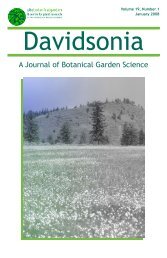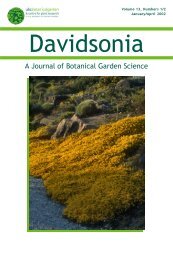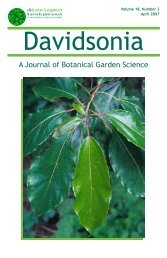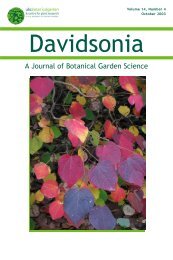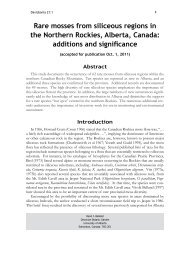Historical Garry Oak Ecosystems of Vancouver Island ... - Davidsonia
Historical Garry Oak Ecosystems of Vancouver Island ... - Davidsonia
Historical Garry Oak Ecosystems of Vancouver Island ... - Davidsonia
You also want an ePaper? Increase the reach of your titles
YUMPU automatically turns print PDFs into web optimized ePapers that Google loves.
34<strong>Historical</strong> <strong>Garry</strong> <strong>Oak</strong> <strong>Ecosystems</strong> <strong>of</strong><strong>Vancouver</strong> <strong>Island</strong>, British Columbia,pre-European Contact to the PresentAbstractThis paper summarizes the historical mapping <strong>of</strong> the major areas <strong>of</strong> Quercusgarryana (<strong>Garry</strong> oak) ecosystems, from immediate pre-European settlement topresent day. Less than 10 percent <strong>of</strong> the original <strong>Garry</strong> oak ecosystem remainson south-eastern <strong>Vancouver</strong> <strong>Island</strong>, British Columbia, Canada. Originally, therewere two major ecosystem types, one on deep soils, known as Parkland <strong>Garry</strong>oak ecosystems, and the second on shallow soils, <strong>of</strong>ten referred to as scrub oakecosystems because the oak trees are <strong>of</strong>ten <strong>of</strong> low stature. Little <strong>of</strong> the deep soilecosystem remains, because these communities were the first areas cleared foragriculture and urban development. More <strong>of</strong> the shallow soil ecosystem remains,as many <strong>of</strong> these rocky areas were more difficult to develop in the early days <strong>of</strong>settlement and were not good for agriculture. However, many <strong>of</strong> these sites arepresently being lost to development if they are not in protected areas. Much <strong>of</strong>the remaining area <strong>of</strong> these ecosystems is dominated by invasive alien plant species,so that less than 5 percent <strong>of</strong> the original area remains in natural condition.IntroductionThe <strong>Garry</strong> oak ecosystem in Canada, also known as ‘Oregon whiteoak ecosystems’ in the United States, is restricted to the southeast coast<strong>of</strong> <strong>Vancouver</strong> <strong>Island</strong>, adjacent Gulf <strong>Island</strong>s and two locations on themainland <strong>of</strong> southwestern BC (Figure 1). This ecosystem is a distinctivefeature <strong>of</strong> the landscape particularly around Victoria, Duncan, Nanaimo,Comox and on most southern Gulf <strong>Island</strong>s. The maps portraying theTed Lea, Vegetation Ecologist<strong>Ecosystems</strong> Branch, British Columbia Ministry <strong>of</strong> EnvironmentVictoria, BC CanadaTed.Lea@gov.bc.ca
35Map: W. Erickson, prepared by HR GISolutionsFigure 1. Distribution <strong>of</strong> <strong>Garry</strong> oak ecosystems in British Columbia (from Erickson, 1993).<strong>Garry</strong> oak distribution in immediate pre-European settlement times(Figures 2, 4, 6 and 8) depict those areas where <strong>Garry</strong> oak was believedto be the dominant cover or co-dominant cover with Pseudotsugamenziesii (Douglas-fir) or Arbutus menziesii (arbutus or madrone) or, inthe Comox area, Pinus contorta var. contorta (shore pine). <strong>Historical</strong> <strong>Garry</strong>oak ecosystem mapping for <strong>Vancouver</strong> <strong>Island</strong>, British Columbia allowscomparisons between the likely pre-European settlement times and thepresent distributions. The study focused on 5 major areas known tosupport the <strong>Garry</strong> oak ecosystem in greater Victoria, Cowichan Valley,Nanaimo, Nanoose, and Comox areas, as well as where it is or was amajor ecosystem on the southern Gulf <strong>Island</strong>s, including Saltspring<strong>Island</strong> and Hornby <strong>Island</strong>. Smaller areas <strong>of</strong> the <strong>Garry</strong> oak ecosystemoccur on many other Gulf <strong>Island</strong>s, mainly along the shoreline and most<strong>of</strong> these remain intact, and are not the focus <strong>of</strong> this study. Other areasmay have had or still have <strong>Garry</strong> oak as a minor component <strong>of</strong> theecosystem; however, they were not considered for this mapping.<strong>Garry</strong> oak ecosystems have been described in detail by Roemer (1972)and Erickson (1995). Originally, there were two major communities
3620%30%40%60%70%100%Map: HR GISolutionsFigure 2. <strong>Garry</strong> oak ecosystems in the greater Victoria area for pre-Europeansettlement.
37Map: HR GISolutionsFigure 3. <strong>Garry</strong> oak ecosystems in the greater Victoria area in 1997.
38recognized within the <strong>Garry</strong> oak ecosystem. Those on deep soils, knownas the Parkland <strong>Garry</strong> oak ecosystem (Pojar, 1980a, 1980b), supportedcommon understory plants including Symphoricarpos albus (snowberry),Camassia leichtlinii and C. quamash (camas), Erythronium oregonum (fawnlily), various graminoid species and Pteridium aquilinum (bracken fern).Almost all <strong>of</strong> this community type has gone, as it occupied areas thatwere most suitable for crops and were cleared for agriculture and urbandevelopment starting in the 1840s. While many large <strong>Garry</strong> oak treesremain, most have lawns, roads, agricultural fields or blacktop beneaththem, rather than the original plant communities. The few examples<strong>of</strong> this ecosystem still remaining include the Nature Conservancy <strong>of</strong>Canada’s Cowichan <strong>Garry</strong> oak preserve, a stand in Beacon Hill Park,Victoria and areas at the Department <strong>of</strong> National Defence lands atRocky Point in Metchosin Municipality.The second major <strong>Garry</strong> oak community type occurs on shallowsoils and is <strong>of</strong>ten referred to as the scrub oak ecosystem. The oak treesare <strong>of</strong>ten <strong>of</strong> lower stature than those growing on deep soils. More <strong>of</strong>this ecosystem remains, probably because many <strong>of</strong> these rocky habitatswere difficult to develop. Many are now in protected areas such asMount Tzuhalem Ecological Reserve, Mount Tolmie Park and MountDouglas Park. The understories <strong>of</strong> these rock outcrop communitieswere originally dominated by many spring flowering perennial forbs,grasses and mosses, but now <strong>of</strong>ten contain extensive cover <strong>of</strong> invasivealien species such as Cytisus scoparius (Scotch broom), agronomic grassesand other weeds.The loss <strong>of</strong> much <strong>of</strong> these ecosystems and recent dominance <strong>of</strong>invasive alien species, has led to more than 100 <strong>Garry</strong> oak-associatedplant and animal species being placed on the BC Species at Risk list.These include more than 75 plant taxa, 2 reptiles, 14 birds, 3 mammals,13 butterflies and 10 other insect species (GOERT 2005). The plantspecies include the Castilleja levisecta (golden paintbrush), Balsamorhizadeltoidea (deltoid balsamroot), Meconella oregana (white meconella), andBartramia stricta (rigid apple moss). Two notable animals are the butterfly,Euchloe ausonides (an undescribed subspecies <strong>of</strong> island marble), which isextirpated, and Contia tenuis (sharp-tailed snake). Unfortunately, species
39at risk numbers are expected to increase as species assessments arecompleted and if the threats to <strong>Garry</strong> oak ecosystems continue.Egan and Howell (2001) recognized a variety <strong>of</strong> information sourcesto determine historical ecology <strong>of</strong> an area, including cultural evidence—land surveys (both mapped and in journals), written records, andhistorical photographs—and biological evidence—forest stand history,observational field evidence, pollen records, geomorphology, hydrologyand soil, and inferring vegetation history. Many <strong>of</strong> these methods wereconsidered in the present study.The objective <strong>of</strong> this mapping was to provide information onthe loss <strong>of</strong> <strong>Garry</strong> oak ecosystems that could be used for a variety <strong>of</strong>purposes, including, understanding the value <strong>of</strong> the remaining pieces,understanding the cultural values associated with these ecosystems,determining which areas might be suitable for restoration orreconstruction <strong>of</strong> these ecosystems and to indicate areas that can beconserved to maintain species at risk.MethodsThe mapping in this study was mainly based on (1) original landsurveys done in the 1850s and 1860s, and (2) recent field observations<strong>of</strong> forest stand history. Maps were prepared at a 1:20,000 scale andincluded areas where <strong>Garry</strong> oak was a dominant or co-dominantcomponent <strong>of</strong> the ecosystem. The land survey maps in the Victoriaarea <strong>of</strong>ten distinguished between coniferous forest and deciduous forestand prairies, as well as larger wetlands. Other data sources used includedwritten records, maps, historical photographs, paintings and some soil,geomorphology and floodplain mapping. An ecosystem map for greaterVictoria was created for the Canadian Forest Service by McMinn et al.(1976) that was used for comparison to known <strong>Garry</strong> oak occurrences.Information on present day areas <strong>of</strong> <strong>Garry</strong> oak ecosystems wasprepared using data from a variety <strong>of</strong> sources, including the SensitiveEcosystem Inventory prepared by the BC Ministry <strong>of</strong> Environment,Lands and Parks (MELP), the BC Conservation Data Centre, MELPNanaimo, and the Canadian Wildlife Service <strong>of</strong> Environment Canada.
40Extensive field work undertaken between 2001 and 2004 establishedpresent distribution <strong>of</strong> oaks, and allowed estimation <strong>of</strong> the pre-Europeanpotential, assuming that the climate has not changed significantly overthe last 200 years. Advice from local ecologists and naturalists whohad considerable experience and expertise was used to determine areasthat had the potential to support <strong>Garry</strong> oak ecosystems before urban,suburban and agricultural development took place in the greater Victoriaarea.The study included a ‘depth <strong>of</strong> soil’ attribute allowing comparison<strong>of</strong> the remaining areas in the parkland and scrub oak ecosystems.Mapping was done on 1:20,000 Terrain Resource Information Mapping(TRIM) base map sheets by indicating the presence <strong>of</strong> existing treesand extrapolation using all sources <strong>of</strong> information and then drawingpolygons depicting pre-European and present day extent <strong>of</strong> theecosystems.Some shortcomings <strong>of</strong> this mapping exercise exist. Data sourceinformation was inconsistent throughout the study area. The mostdetailed land survey maps, which show the differences in vegetative cover,are only available in parts <strong>of</strong> the greater Victoria area. However, therewas no record <strong>of</strong> vegetation cover for either Colwood or Esquimalt.Similarly, survey information for areas farther north on <strong>Vancouver</strong><strong>Island</strong> was restricted by property lot boundaries. Some areas had soilsand floodplain mapping while other areas did not. In some historicaloak areas, where Douglas fir has now replaced <strong>Garry</strong> oak, there mayhave been cover underestimations, especially where less detailed landsurvey information was available.ResultsThe maps (Figures 2 through 9) and Table 1 allow comparison<strong>of</strong> the <strong>Garry</strong> oak ecosystem distribution on <strong>Vancouver</strong> <strong>Island</strong> inimmediate pre-European settlement times and now. Table 1 showsthat approximately 10 percent <strong>of</strong> the area that was originally <strong>Garry</strong> oakecosystem now remains as remnants. However, since much <strong>of</strong> this areais now dominated by invasive alien species, less than 5 percent <strong>of</strong> the
41Table 1. Area coverage <strong>of</strong> the <strong>Vancouver</strong> <strong>Island</strong> <strong>Garry</strong> oakaecosystems for pre-European settlement and present day,broken into deep and shallow soil ecosystems.DeepPre-EuropeanDeepPresentDayShallowPre-EuropeanShallowPresentDayOverallPre-EuropeanOverallPresentDayGreater Victoria 9564 ha 45 ha 890 ha 440 ha 10454 ha 485 haCowichan Valley/Saltspring <strong>Island</strong>1824 ha 83 ha 1301 ha 619 ha 3125 ha 702 haNanaimo/Nanoose29 ha 29 ha 951 ha 298 ha 980 ha 327 haComox 527 ha 7 ha 0 ha 0 ha 527 ha 7 haHornby/Denman <strong>Island</strong>65 ha 11 ha 98 ha 57 ha 163 ha 68 haTotal 12009 ha 175 ha 3240 ha 1414 ha 15249 ha 1589 haPercent <strong>of</strong> Original 1.5% 44% 10%
42Map: HR GISolutionsFigure 4. <strong>Garry</strong> oak ecosystems in the Cowichan Valley and Saltspring <strong>Island</strong> areafor pre-European settlement.original ecosystem remains in a near-natural condition, where nativespecies dominate the understorey. Most <strong>of</strong> the remnants are in isolated,fragmented locations that have no connection to other <strong>Garry</strong> oak areas.The remaining remnant areas <strong>of</strong> <strong>Garry</strong> oak ecosystems are dominatedby invasive alien plant species such as Scotch broom, agronomic grassesand weedy forbs.On the maps, the original pre-European distribution <strong>of</strong> <strong>Garry</strong> oakecosystems is displayed in green, while the remaining present day areasare shown in red. For the mapping, shading is used to indicate thepercentage <strong>of</strong> <strong>Garry</strong> oak ecosystems occurring in a particular polygon.The darkest shade means that one hundred percent <strong>of</strong> an area was<strong>Garry</strong> oak ecosystem, while the lightest shade indicates that ten percent
43<strong>of</strong> the area would be <strong>Garry</strong> oak ecosystem, and the other ninety percentwould be another type <strong>of</strong> ecosystem. This was determined using allavailable data sourcesThe Victoria area (Figures 2 and 3) had mainly deep soil <strong>Garry</strong>oak ecosystems (9564 ha). Very little <strong>of</strong> this ecosystem remains (45ha). Less shallow soil ecosystem occurred originally (890 ha), and agreater percentage (440 ha) remains to date. In the Cowichan Valleyand on Saltspring <strong>Island</strong> (Figures 4 and 5), deeper soil areas (1824 ha)were more common than shallow soil ecosystems (1301 ha), but as inVictoria, a greater percentage <strong>of</strong> shallow soils (619 ha) remains. Forthe Nanaimo and Nanoose areas (Figures 6 and 7), very little deep soilecosystem (29 ha) occurred in the 1800s and all <strong>of</strong> it is still present.Map: HR GISolutionsFigure 5. <strong>Garry</strong> oak ecosystems in the Cowichan Valley and Saltspring <strong>Island</strong> areafor present day.
44Map: HR GISolutionsFigure 6. <strong>Garry</strong> oak ecosystems in the Nanaimo and Nanoose areas forpre-European settlement.Approximately one third (298 ha) <strong>of</strong> the original (951 ha) shallow soilecosystem still remains. In the Comox Valley and Hornby/Denman<strong>Island</strong> areas (Figures 8 and 9) areas, deep soils ecosystems were originallyfairly limited (592 ha) and little remains (18 ha). No measurable shallowsoil ecosystem occurred in the Comox Valley, but on Hornby <strong>Island</strong> 98ha originally occurred and over one half <strong>of</strong> this (57 ha) still remains.Overall, for <strong>Vancouver</strong> <strong>Island</strong>, only 1.5 percent <strong>of</strong> the original deepsoil <strong>Garry</strong> oak ecosystem remains, while approximately 44 percent <strong>of</strong>shallow soil <strong>Garry</strong> oak ecosystem remains.
45DiscussionMapping ecosystems over time allows us to record the historicalecosystem loss and to identify areas with potential for restoration. Italso allows landscape managers to understand regional heritage, howhumans have affected ecosystems, the importance <strong>of</strong> the remainingareas <strong>of</strong> an ecosystem, and to make general predictions about futurevegetation that may result from climate change. Measurement <strong>of</strong>ecosystem loss allows us to assess the importance <strong>of</strong> the remainingareas, especially in the <strong>Garry</strong> oak ecosystems, which contain largenumbers <strong>of</strong> species at risk (Fuchs 2000). Many species at risk are notadequately supported if the ecosystem is reduced in size or otherwisedegraded. Preservation and stewardship <strong>of</strong> the remaining areas willMap: HR GISolutionsFigure 7. <strong>Garry</strong> oak ecosystems in the Nanaimo and Nanoose areas for present day.
46Map: HR GISolutionsFigure 8. <strong>Garry</strong> oak ecosystems in the Comox, and Hornby <strong>Island</strong> areas forpre-European settlement.be essential.While the maps provide substantial information about the changesand current existence <strong>of</strong> major fragments <strong>of</strong> the <strong>Garry</strong> oak ecosystem,they give less detailed insight to the original conditions which we mustunderstand more fully before restoration is attempted (MacDougall etal., 2004). <strong>Historical</strong> mapping generally only gives one point in time andusually does not describe the detailed plant composition <strong>of</strong> communitiesthat existed 150 to 200 years ago. Often restoration workers seem tohave selected a particular successional community and tried to managetheir area to that “ideal state.” In the case <strong>of</strong> <strong>Garry</strong> oak stands, this is<strong>of</strong>ten an oak savanna or oak woodland with a meadow-like understorey<strong>of</strong> camas, fawn lily and other attractive flowers, but many other stagescould also be appropriate (see Peter and Harrington 2004). As with
47Map: HR GISolutionsFigure 9. <strong>Garry</strong> oak ecosystems in the Comox, and Hornby <strong>Island</strong> areas forpresent day.many natural ecosystems, successional stages <strong>of</strong>ten existed in mosaics inthe landscape, depending on disturbance history. A very important part<strong>of</strong> the <strong>Garry</strong> oak landscape for thousands <strong>of</strong> years was the influence <strong>of</strong>First Nations people who burned many areas for maintenance <strong>of</strong> plantresources such as camas, and other root crops, such as bracken fern(Turner 1999).According to this study, only 10 percent <strong>of</strong> the <strong>Garry</strong> oak ecosystemthat existed in immediate pre-European settlement times, remains now.These ecosystems are now critically imperilled, due to their rapid losssince the European migration to <strong>Vancouver</strong> <strong>Island</strong> beginning in the1800s. Losses <strong>of</strong> these ecosystems continue even today, except forthe small remnants that occur on some hilltops protected in parks andEcological Reserves. Invasive alien species dominate most <strong>of</strong> these
48fragmented areas. The future for <strong>Garry</strong> oak ecosystems is not bright.Some individuals have suggested that with climate change, the range<strong>of</strong> <strong>Garry</strong> oak ecosystems could expand (Hebda, 2004). I believe thatQ. garryana may have the potential to expand its range as an individualspecies, but natural understorey components may not be able to expandand compete with the many alien species that now occur. The only wayto maintain this ecosystem will be with extensive human intervention, ata significant cost <strong>of</strong> both money and human effort. The main lessons tobe learned from this study are (1) that slow, but continued human landuse can largely eliminate ecosystems over time, and (2) a fact overlookedas coming generations only know what they see is that historical mappingshows us what we have lost and what we have forgotten. Unless humansfind a way to protect rare ecosystems, through a variety <strong>of</strong> mechanisms,including legislation (similar to present laws covering species at risk), aswell as stewardship and restoration activities, many more ecosystems atrisk may be lost.The following activities must be considered to improve the survivalpossibilities for <strong>Garry</strong> oak ecosystems: protect the remnants; deal withinvasive species; restore suitable areas; purchase lands for conservation;promote stewardship on private lands; assess the potential to introduceappropriate species at risk; prevent other ecosystems from becomingthreatened; and plan for climate change.AcknowledgementsSpecial thanks go to Jan Kirkby and Carmen Cadrin forencouragement throughout the mapping project. I thank Kate Millerfor her assistance in mapping the Cowichan Valley, Saltspring <strong>Island</strong>,Nanaimo and Nanoose areas. Thanks to Lora Lea, Griffin Lea, JannaLea, Bob Maxwell, Carmen Cadrin, Andy MacKinnon, Moralea Milne,Kate Miller, Alex Miller, Miles Miller, Brent Ingram, and CarolynMacDonald for their field assistance checking the present locations <strong>of</strong><strong>Garry</strong> oak trees, and ecosystems. The map <strong>of</strong> <strong>Garry</strong> oak distributionin British Columbia is from Erickson (1993). Funding was providedby the BC Ministry <strong>of</strong> Sustainable Resource Management, Ministry <strong>of</strong>
49Water, Land and Air Protection, BC Ministry <strong>of</strong> Environment, ParksCanada and Forest Renewal British Columbia. Digital Products are byDuncan Richards and Dan Horth <strong>of</strong> HR GISolutions. Thanks to GaryBradfield, Brenda Costanzo, Lora Lea and an anonymous individual forreviewing drafts <strong>of</strong> this paper.ReferencesBritish Columbia Land Surveys. 1858, 1859, 1860. Land surveys <strong>of</strong> the Victoria,Central Saanich, North Saanich, Lakes and Metchosin Districts. Victoria:BC Crown Land Registry Office, BC.BC Ministry <strong>of</strong> Environment, Lands and Parks and Environment Canada. 1997.Sensitive Ecosystem Inventory <strong>of</strong> Eastern <strong>Vancouver</strong> <strong>Island</strong> and the Gulf<strong>Island</strong>s. 1:20,000 maps.Egan, D. and Howell, E.A. (editors). 2001. The <strong>Historical</strong> Ecology Handbook:A Restorationist’s Guide to Reference <strong>Ecosystems</strong>. Washington, DC:<strong>Island</strong> Press. 457 pp.Erickson, W. 1993. <strong>Garry</strong> oak <strong>Ecosystems</strong>. <strong>Ecosystems</strong> in British Columbiaat Risk Series. Conservation Data Centre, Wildlife Branch. Victoria: BCMinistry <strong>of</strong> Environment, Lands and Parks. 6pp.Erickson, W. 1995. Classification and interpretation <strong>of</strong> <strong>Garry</strong> oak (Quercusgarryana) plant communities and ecosystems in southwestern British Columbia.MSc. Thesis. Department <strong>of</strong> Geography, University <strong>of</strong> Victoria,Victoria, BC. 307 pp.Fuchs, M. 2000. Towards a recovery strategy for <strong>Garry</strong> oaks and associatedecosystems in Canada: Ecological Assessment and Literature Review.Environment Canada, Canadian Wildlife Service. 106 pp.GOERT. 2005. <strong>Garry</strong> <strong>Oak</strong> <strong>Ecosystems</strong> Recovery Team website.www.goert.ca Accessed October 1, 2006.Hebda, R.J. 2004. Paleoecology, climate change and forecasting the future <strong>of</strong>species at risk. In L<strong>of</strong>roth, E.C. and T.D. Hooper (editors). Proceedings<strong>of</strong> the Species at Risk 2004. Pathways to Recovery, Victoria, BC
50MacDougall, A.S., Beckwith, B.R. and Maslovat, C.Y. 2004. Defining conservationstrategies with historical perspectives: a case study from a degradedoak grassland ecosystem. Conservation Biology 18: 455-465.McMinn, R.G., Eis, S., Hirvonen, H. E. Oswald E.T. and Senyk, J.P. 1976.Native Vegetation in British Columbia’s Capital Region. Forest Service,Environment Canada.Penn, B. 1992. The last <strong>of</strong> the <strong>Garry</strong> oaks. Monday Magazine, February 27 -March 4., Monday Publications, Victoria, BC. pp.6-8.Peter, D. and Harrington, C. 2004. Quercus garryana Acorn Production Study[Online.] 6 p. Available at: http://www.fs.fed.us/pnw/olympia/silv/oakstudies/acorn_survey/survey-background.shtml(accessed 08 May 2004;verified 18 October 2006). Olympia, WA: USDA Forest Service, PNWResearch Station,Pojar, J. 1980a. Threatened Forest <strong>Ecosystems</strong> <strong>of</strong> British Columbia. In Proceedings<strong>of</strong> the Symposium: Threatened and Endangered Species and Habitatsin British Columbia and the Yukon. Edited by R. Stace-Smith, L. Johns andP. Joslin. Federation <strong>of</strong> BC Naturalists, Douglas College and BC Ministry<strong>of</strong> Environment. pp 28-39.Pojar, J. 1980b. Threatened Habitats <strong>of</strong> Rare Vascular Plants in British Columbia.In Proceedings <strong>of</strong> the Symposium: Threatened and Endangered Speciesand Habitats in British Columbia and the Yukon. Edited by R. Stace-Smith,L. Johns and P.Joslin. Federation <strong>of</strong> BC Naturalists, Douglas College andBC Ministry <strong>of</strong> Environment. pp 40-48.Roemer, H. 1962. Forest vegetation and environments on the Saanich Peninsula,<strong>Vancouver</strong> <strong>Island</strong>. PhD. Thesis, Department <strong>of</strong> Biology. University <strong>of</strong>Victoria, Victoria, BC 292pp.Turner, N.J. 1999. Time to Burn: Traditional use <strong>of</strong> fire to enhance resourceproduction by Aboriginal peoples in British Columbia. In Indians, fireand the land in the Pacific Northwest. Edited by R. Boyd. Corvallis OR:Oregon State University Press. pp 194 – 211.



